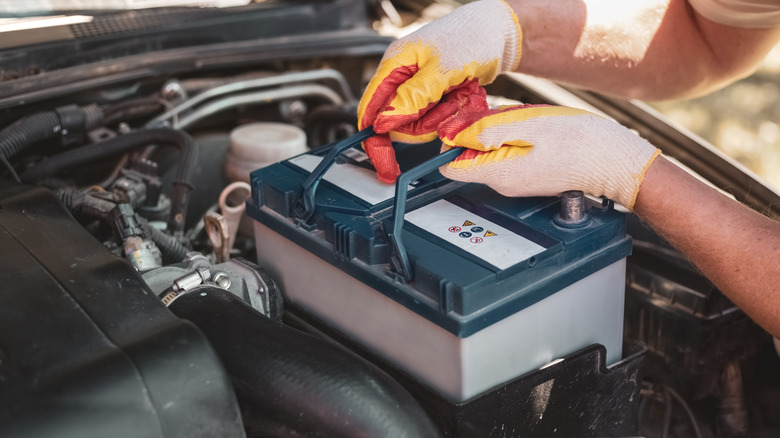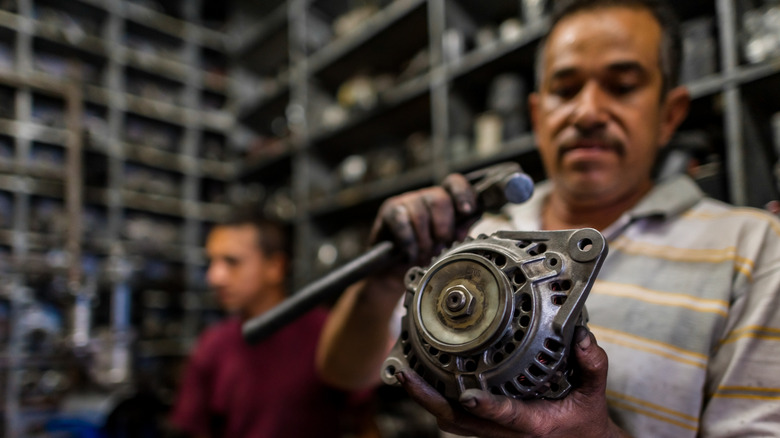Do Car Batteries Lose Charge When Not In Use? Parasitic Drain, Explained
Whether in our cars, phones, or other devices, we sometimes find that those precious batteries seem to lose charge quicker than we'd expect. In a similar fashion, our electronics left on standby can still use a certain amount of power. In both cases, we're not technically using the battery/device when it's not in use, but a pesky power drain may be happening anyway.
Appliances such as smart plugs use a small degree of energy while in standby, and standby more broadly is subject to a so-called vampire energy drain. Our devices can use up a surprising amount of power just while waiting in a state of readiness, and this extends to car batteries, which are subject to the horrors of parasitic drain. So many of today's cars have a wide range of smart functions, which means that, even when the vehicle is off, some of these battery-powered features continue to run. The result of this is that you don't have the remaining battery you might expect, and this is sometimes due to features you may even have forgotten about.
The Universal Technical Institute states that "typically, the normal amount of parasitic draw is between 50 and 85 milliamps in newer cars and less than 50 milliamps for older cars." As such, it's completely normal for a vehicle to lose some battery power all the time, even when parked. However, parasitic drain is not only the harmless and minor ticking away of essential features like your vehicle's alarm. The drain, should there be issues with wiring, your battery, or a third-party component, for instance, can be much more severe. Drivers need to be vigilant for the signs of parasitic drain and understand the possible actions they can take to detect and eliminate/minimize it.
The impact of parasitic drain on a car's battery
Lacking juice will lead to a wide range of fundamental issues, such as difficulties starting the engine. This is why it's vital to keep track of battery levels and to be sure to shut off any functions you can while parked. Even having done so, though, the problem can persist. The key, as with identifying certain ailments with our own bodies, is to determine how much is typical for your specific case and to be wary when things are significantly different from the norm.
All drivers have surely known the stress of dashing to their cars, late for an appointment, only to find the battery has unexpectedly run down. There are certain telltale signs that it's time to replace your car's battery that veteran drivers will recognize, and you'll probably find them cropping up sooner rather than later if your vehicle's subject to parasitic drain.
For all these reasons, if you find that your vehicle seems to be draining by itself at a faster rate than it should, a trusted mechanic can be your first port of call for diagnosing the problem, but if you know what you're looking for, you can test to try and do so yourself. A multimeter is invaluable for this task, first measuring the battery's voltage and then, via its direct current setting, determining whether the level of power being drawn is higher than it ought to be. If that's the case, monitoring the reading while slowly removing fuses will, through the process of elimination, reveal which connection is causing the issue.
What you can do about parasitic drain
The all-important alarm system will drain continually while the vehicle's not being driven, and that's probably not something you can afford to be without. Features like these account for a normal level of drain, but for the more severe – parasitic drain is one of the major reasons your car battery might be draining so fast – there are some ways to tackle it.
Auto Trader notes that, when the impact of the drain is pronounced, it's probably time to check that everything's in working order with your car. Heavy, continual drain is a common sign that something significant, such as your vehicle's lights, isn't working as intended. Wrongly fitted parts can be a frequent contributing factor to parasitic drain issues. If you've had any such work completed on your car, or are scheduled to, it's prudent to monitor your battery's performance in the aftermath. A short circuit or an issue with a relay can also be a potential cause, and because the electrical systems of vehicles are so complex, it's vital to locate the issue and then determine exactly what it is, which often calls for a professional touch.
Conscientious drivers, naturally, will be in the habit of doing so anyway, but in the process of performing your regular checks and TLC on your vehicle components, keep your vehicle's alternator in mind in particular. This part, because it has a vital role in powering others, can act as a warning system of anything potentially being amiss. With other vehicle components, it's common that more wear means more susceptibility to parasitic drain, so take heed of the manufacturer's advice when it comes to servicing needs and the time period that has elapsed between replacements as needed.


